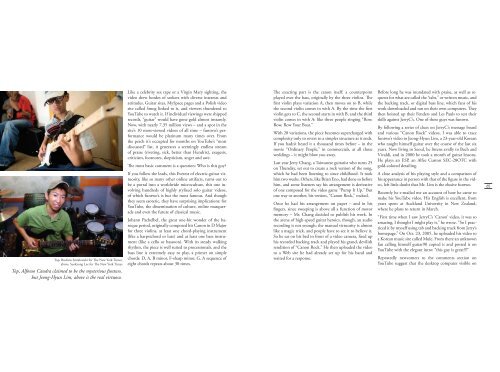The Korean Wave 2006 - Korean Cultural Service
The Korean Wave 2006 - Korean Cultural Service
The Korean Wave 2006 - Korean Cultural Service
Create successful ePaper yourself
Turn your PDF publications into a flip-book with our unique Google optimized e-Paper software.
64<br />
Top, Bredans Smialowski for <strong>The</strong> New York Times;<br />
above, Seokyong Lee for <strong>The</strong> New York Times<br />
Like a celebrity sex tape or a Virgin Mary sighting, the<br />
video drew hordes of seekers with diverse interests and<br />
attitudes. Guitar sites, MySpace pages and a Polish video<br />
site called Smog linked to it, and viewers thundered to<br />
YouTube to watch it. If individual viewings were shipped<br />
records, “guitar” would have gone gold almost instantly.<br />
Now, with nearly 7.35 million views – and a spot in the<br />
site’s 10 most-viewed videos of all time – funtwo’s performance<br />
would be platinum many times over. From<br />
the perch it’s occupied for months on YouTube’s “most<br />
discussed” list, it generates a seemingly endless stream<br />
of praise (riveting, sick, better than Hendrix), exegesis,<br />
criticism, footnotes, skepticism, anger and awe.<br />
<strong>The</strong> most basic comment is a question: Who is this guy?<br />
If you follow the leads, this Everest of electric-guitar virtuosity,<br />
like so many other online artifacts, turns out to<br />
be a portal into a worldwide microculture, this one involving<br />
hundreds of highly stylized solo guitar videos,<br />
of which funtwo’s is but the most famous. And though<br />
they seem esoteric, they have surprising implications: for<br />
YouTube, the dissemination of culture, online masquerade<br />
and even the future of classical music.<br />
Johann Pachelbel, the great one-hit wonder of the baroque<br />
period, originally composed his Canon in D Major<br />
for three violins, at least one chord-playing instrument<br />
(like a harpsichord or lute) and at least one bass instrument<br />
(like a cello or bassoon). With its steady walking<br />
rhythm, the piece is well suited to processionals, and the<br />
bass line is extremely easy to play, a primer on simple<br />
chords: D, A, B minor, F-sharp minor, G. A sequence of<br />
eight chords repeats about 30 times.<br />
<strong>The</strong> exacting part is the canon itself: a counterpoint<br />
played over the bass, originally by the three violins. <strong>The</strong><br />
first violin plays variation A, then moves on to B, while<br />
the second violin comes in with A. By the time the first<br />
violin gets to C, the second starts in with B, and the third<br />
violin comes in with A: like three people singing “Row,<br />
Row, Row Your Boat.”<br />
With 28 variations, the piece becomes supercharged with<br />
complexity only to revert to a simpler structure as it ends.<br />
If you hadn’t heard it a thousand times before – in the<br />
movie “Ordinary People,” in commercials, at all those<br />
weddings – it might blow you away.<br />
Last year Jerry Chang, a Taiwanese guitarist who turns 25<br />
on Thursday, set out to create a rock version of the song,<br />
which he had been listening to since childhood. It took<br />
him two weeks. Others, like Brian Eno, had done so before<br />
him, and some listeners say his arrangement is derivative<br />
of one composed for the video game “Pump It Up.” But<br />
one way or another, his version, “Canon Rock,” rocked.<br />
Once he had his arrangement on paper – and in his<br />
fingers, since sweeping is above all a function of motor<br />
memory – Mr. Chang decided to publish his work. In<br />
the arena of high-speed guitar heroics, though, an audio<br />
recording is not enough; the manual virtuosity is almost<br />
like a magic trick, and people have to see it to believe it.<br />
So he sat on his bed in front of a video camera, fired up<br />
his recorded backing track and played his grand, devilish<br />
rendition of “Canon Rock.” He then uploaded the video<br />
to a Web site he had already set up for his band and<br />
waited for a response.<br />
Before long he was inundated with praise, as well as requests<br />
for what are called the “tabs,” or written music, and<br />
the backing track, or digital bass line, which fans of his<br />
work downloaded and ran on their own computers. <strong>The</strong>y<br />
then hoisted up their Fenders and Les Pauls to test their<br />
skills against JerryC’s. One of these guys was funtwo.<br />
By following a series of clues on JerryC’s message board<br />
and various “Canon Rock” videos, I was able to trace<br />
funtwo’s video to Jeong-Hyun Lim, a 23-year-old <strong>Korean</strong><br />
who taught himself guitar over the course of the last six<br />
years. Now living in Seoul, he listens avidly to Bach and<br />
Vivaldi, and in 2000 he took a month of guitar lessons.<br />
He plays an ESP, an Alfee Custon SEC-28OTC with<br />
gold-colored detailing.<br />
A close analysis of his playing style and a comparison of<br />
his appearance in person with that of the figure in the video,<br />
left little doubt that Mr. Lim is the elusive funtwo.<br />
Recently he e-mailed me an account of how he came to<br />
make his YouTube video. His English is excellent, from<br />
years spent at Auckland University in New Zealand,<br />
where he plans to return in March.<br />
“First time when I saw JerryC’s ‘Canon’ video, it was so<br />
amazing, I thought I might play it,” he wrote. “So I practiced<br />
it by myself using tab and backing track from Jerry’s<br />
homepage.” On Oct. 23, 2005, he uploaded his video to<br />
a <strong>Korean</strong> music site called Mule. From there an unknown<br />
fan calling himself guitar90 copied it and posted it on<br />
YouTube with the elegant intro: “this guy iz great!!!”<br />
Repeatedly newcomers to the comments section on<br />
YouTube suggest that the desktop computer visible on<br />
65<br />
Top, Alfonso Candra claimed to be the mysterious funtwo,<br />
but Jeong-Hyun Lim, above is the real virtuoso.





